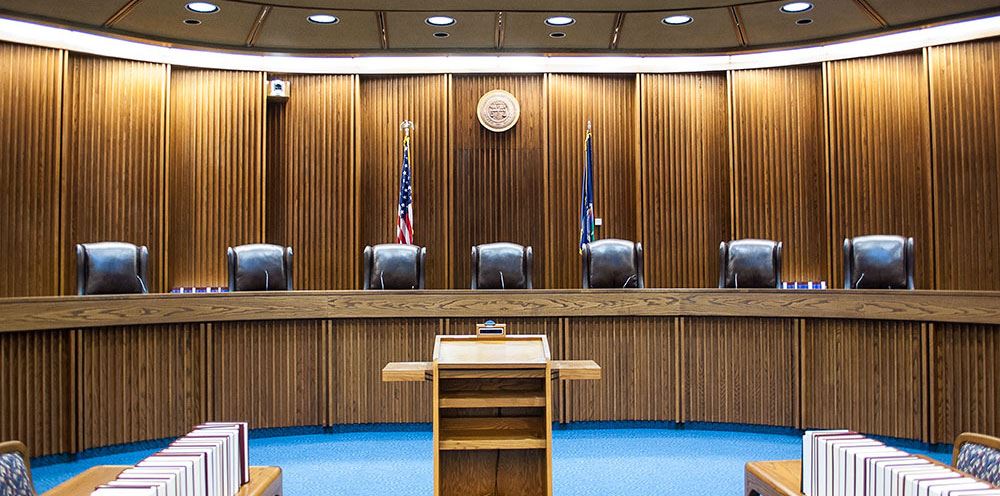In 2018, Shelbie Ellis, a female customer, entered a convenience store restroom but never came back out. After 45 minutes the clerk called the police. Later joined by a second officer, the first officer arrived and contacted Shelbie in the restroom. After being asked if she was alright, Shelbie said that she was having stomach issues. The officer did not ask if she needed medical attention, but did ask for Shelbie’s driver’s license. Shelbie voluntarily gave over her license which the officer then kept. The officer ran a warrant check with the information, asked further questions of Shelbie, but never returned the license. The two officers and Shelbie later moved from the restroom to the parking lot to check for the arrival of Shelbie’s intended ride. After some additional back and forth outside, the officer inquired about Shelbie’s drug use, and asked if he could search her purse. Shelbie declined the search. Within a few minutes the dispatcher told the officers that there was an outstanding out-of-county arrest warrant for Shelbie. The officers arrested her on the warrant, and upon a search of her purse incident to the arrest, officers found methamphetamine and a pipe. The event had lasted between 5 and 10 minutes.
After the trial court denied Shelbie’s suppression motion and found her guilty of the meth possession, she appealed. A panel of the Kansas Court of Appeals recently reversed her conviction holding that the meth had been illegally seized and should have been suppressed.
First, the out-of-county arrest warrant and the case underpinning that arrest warrant is not affected by this illegal seizure holding. Only the new meth evidence found in Shelbie’s purse, and the new and separate criminal case arising from the meth, has been damaged.
Second, why then the suppression of the meth? We have discussed this issue before, and Kansas law has been settled for some time.
At the suppression hearing, the officer agreed that he had been dispatched on a welfare check, and that at no time prior to learning about the outstanding arrest warrant did he have reasonable suspicion that Shelbie had, was, or was about to commit a crime.
“Welfare checks—which are constitutionally analogous to public-safety stops—fall under law enforcement’s community-caretaking function. These encounters occur when an officer checks on a person’s welfare for safety or assistance reasons . . . A welfare check ‘is not for investigative purposes’ . . . Rather, it must be ‘divorced from the detection, investigation, or acquisition of evidence relating to the violation of a criminal statute.”
Kansas courts use a three-part test to define the contours of a valid welfare check: 1) an officer has the right to stop or investigate when there are objective, specific, and articulable facts to suspect that a person needs help or is in peril; 2) if the person needs help, the officer may take the appropriate steps to render assistance; and, 3) when the officer believes that the person is no longer in need of assistance, any further actions constitute a seizure. “These considerations differentiate welfare checks and public-safety stops—which are performed under law enforcement’s caretaking function—from investigative detentions [based upon reasonable suspicion of criminal activity] and arrests [based upon probable cause of criminal activity] . . .”
When an officer holds on to a driver’s license or other property, a reasonable person will not believe that they have the right to leave. Legally, that means that Shelbie was being detained (whether the officer realized it or not), and because the officer did not have reasonable suspicion that a crime was being committed, that detention was unlawful. Thus, because the detention was illegal any evidence flowing from the detention should probably have been suppressed. [There are circumstances when the Exclusionary Rule would not have applied, but the panel held that those are not present here. The State had also argued that Shelbie had voluntarily given over her license, but the panel dismissed that contention too because the officer had kept the license during the NCIC check and questioning. “This court has held on multiple occasions . . . that an officer goes beyond the permissible scope of a welfare check or public-safety stop by retaining a person’s identification and running a records check for wants and warrants.”].
So, bottom line and best practice: officers should remember that they have no authority to compel identification from a person at a welfare check; and once it is found that the person does not need further assistance, then the officer should just leave. Police practice or department policy or supervisor directions notwithstanding. Such practices do not override the Constitution.
In Shelbie’s case, after Shelbie had made it clear that she did not need assistance: 1) the officers should have left; or, 2) at most, the officers could have asked for Shelbie’s affirmative consent to identify herself. And, after obtaining the identification, the officers should have immediately returned the ID, walked away, run the warrant check away from Shelbie, and when it hit, re-contacted Shelbie and arrested her on the warrant. It was the retention of the DL, the close remaining with Shelbie, and all of the unnecessary questioning that the panel justifiably did not like.
Lastly, there is an unfortunate comment by the panel in this case that the defense bar may cite to in the future. The panel hints that no person’s identification obtained at a welfare check, even given voluntarily and under no-detention circumstances, can be used for a warrant/NCIC check because that police action would be a “criminal investigation.” The panel’s comment is not supported in the case law, and interestingly the panel does not cite to any. Why? Probably because no person has an expectation of privacy in their personal criminal information inside of a warrant file or in the NCIC database.
Colin


